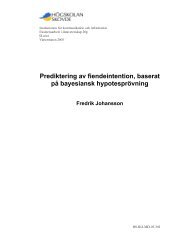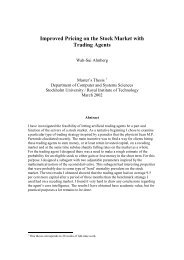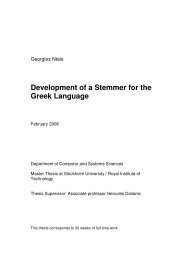Modeling Hydra Behavior Using Methods Founded in Behavior-Based Robotics
Modeling Hydra Behavior Using Methods Founded in ... - SAIS
Modeling Hydra Behavior Using Methods Founded in ... - SAIS
Create successful ePaper yourself
Turn your PDF publications into a flip-book with our unique Google optimized e-Paper software.
54 Appendix A. Evolutionary algorithmsInitialize population❄✲ Evaluate <strong>in</strong>dividual❄✲ Select <strong>in</strong>dividuals❄Perform crossoverNo❄Mutate❄ ✏ ✏✏✏✏✏✏ ✏ New pop. complete?✏ ✏✏✏✏✏No❄Yes ✏ ✏✏✏✏✏✏ ✏ Term<strong>in</strong>ate?✏ ✏✏✏✏✏✎✍❄YesEnd☞✌Figure A.1: Flow of a general EA.encod<strong>in</strong>g, which was used for parametrical and structural optimization of RNNs, there isno encod<strong>in</strong>g/decod<strong>in</strong>g, but the EA operates directly on the structure of the <strong>in</strong>dividual (theRNN <strong>in</strong> this case). In real number encod<strong>in</strong>g, the <strong>in</strong>formation is stored <strong>in</strong> chromosomes,where each gene consists of a real number with<strong>in</strong> a pre-def<strong>in</strong>ed range.A.2 Fitness function<strong>Based</strong> on its performance each <strong>in</strong>dividual is assigned a fitness value. The choice of fitnessfunction depends on the problem at hand. In this project, the fitness measure was taken asthe <strong>in</strong>verse of the RMSE over the tra<strong>in</strong><strong>in</strong>g data set, as described <strong>in</strong> Section 7.1.2.A.3 SelectionSelection of two parents can be accomplished <strong>in</strong> several ways. In this project, tournamentselection is used. In tournament selection N <strong>in</strong>dividuals are randomly chosen from





